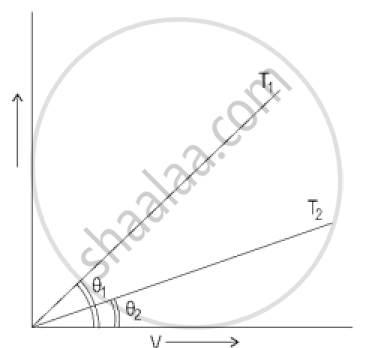Advertisements
Advertisements
प्रश्न
A resistor of resistance 100 Ω is connected to an AC source ε = (12 V) sin (250 π s−1)t. Find the energy dissipated as heat during t = 0 to t = 1.0 ms.
उत्तर
Given:
Peak voltage of AC source, E0 = 12 V
Angular frequency, ω = 250 πs−1
Resistance of resistor, R = 100 Ω
Energy dissipated as heat (H) is given by,
`H = E_{rms}/R T`
Here,
Erms = RMS value of voltage
R = Resistance of the resistor
T = Temperature
Energy dissipated as heat during t = 0 to t = 1.0 ms.
`H = ∫_0^t dH`
= `∫ (E_0^2 sin^2 omega t)/R dt (therefore E_{rms = E_0 sin omega t})`
= `144/100 ∫_0^{10-3} sin^2 omegat dt`
=` 1.44/2 ∫_0^{10-3} ((1-cos 2 omegat)/2)dt`
=`1.44/2 [ ∫_0^{10-3} dt + ∫_0^{10-3} cos 2 omega t dt]`
= `0.72 [ 10^-3 - {(sin 2 omegat)/(2 omega) }]_0^(10-3)]`
`= 0.72[1/1000 - 1/(1000pi)]`
`=0.72 [1/1000 - 2/(1000pi)]`
`= ((pi - 2)/(1000pi)) xx 0.72`
`= 0.0002614 = 2.61 xx 10^-4 J`
APPEARS IN
संबंधित प्रश्न
A device X is connected across an ac source of voltage V = V0 sin ωt. The current through X is given as
`I = I_0 sin (omega t + pi/2 )`
1) Identify the device X and write the expression for its reactance.
2) Draw graphs showing the variation of voltage and current with time over one cycle of ac, for X.
3) How does the reactance of the device X vary with the frequency of the ac? Show this variation graphically.
4) Draw the phasor diagram for the device X.
The given graph shows the variation of photo-electric current (I) versus applied voltage (V) for two difference photosensitive materials and for two different intensities of the incident radiations. Identify the pairs of curves that correspond to different materials but same intensity of incident radiation.

Two alternating currents are given by `i_1 = i_0 sin wt and i_2 = i_0 sin (wt + pi/3)` Will the rms values of the currents be equal or different?
Can a hot-wire ammeter be used to measure a direct current of constant value? Do we have to change the graduations?
An alternating current is given by i = i1 cos ωt + i2 sin ωt. The rms current is given by
An alternating current of peak value 14 A is used to heat a metal wire. To produce the same heating effect, a constant current i can be used, where i is
A constant current of 2.8 A exists in a resistor. The rms current is
An electric bulb is designed to operate at 12 volts DC. If this bulb is connected to an AC source and gives normal brightness, what would be the peak voltage of the source?
The peak power consumed by a resistive coil, when connected to an AC source, is 80 W. Find the energy consumed by the coil in 100 seconds, which is many times larger than the time period of the source.
A capacitor of capacitance 10 μF is connected to an oscillator with output voltage ε = (10 V) sin ωt. Find the peak currents in the circuit for ω = 10 s−1, 100 s−1, 500 s−1 and 1000 s−1.
In a series RC circuit with an AC source, R = 300 Ω, C = 25 μF, ε0 = 50 V and ν = 50/π Hz. Find the peak current and the average power dissipated in the circuit.
Do the same with the replacement of the earlier transformer by a 40,000-220 V step-down transformer (Neglect, as before, leakage losses though this may not be a good assumption any longer because of the very high voltage transmission involved). Hence, explain why high voltage transmission is preferred?
The period of oscillation of a simple pendulum is T = `2π sqrt"L"/"g"`. The measured value of L is 20.0 cm known to have 1 mm accuracy and the time for 100 oscillations of the pendulum is found to be 90 s using a wristwatch of ls resolution. The accuracy in the determination of g is:
Phase diffn between voltage and current in a capacitor in A.C Circuit is.
In a transformer Np = 500, Ns = 5000. Input voltage is 20 volt and frequency is 50 HZ. Then in the output, we have,
When a voltage measuring device is connected to AC mains, the meter shows the steady input voltage of 220V. This means ______.
RMS value of an alternating current flowing in a circuit is 5A. Calculate its peak value.
In the Figure below, the current-voltage graphs for a conductor are given at two different temperatures, T1 and T2.

- At which temperature T1 or T2 is the resistance higher?
- Which temperature (T1 or T2) is higher?
